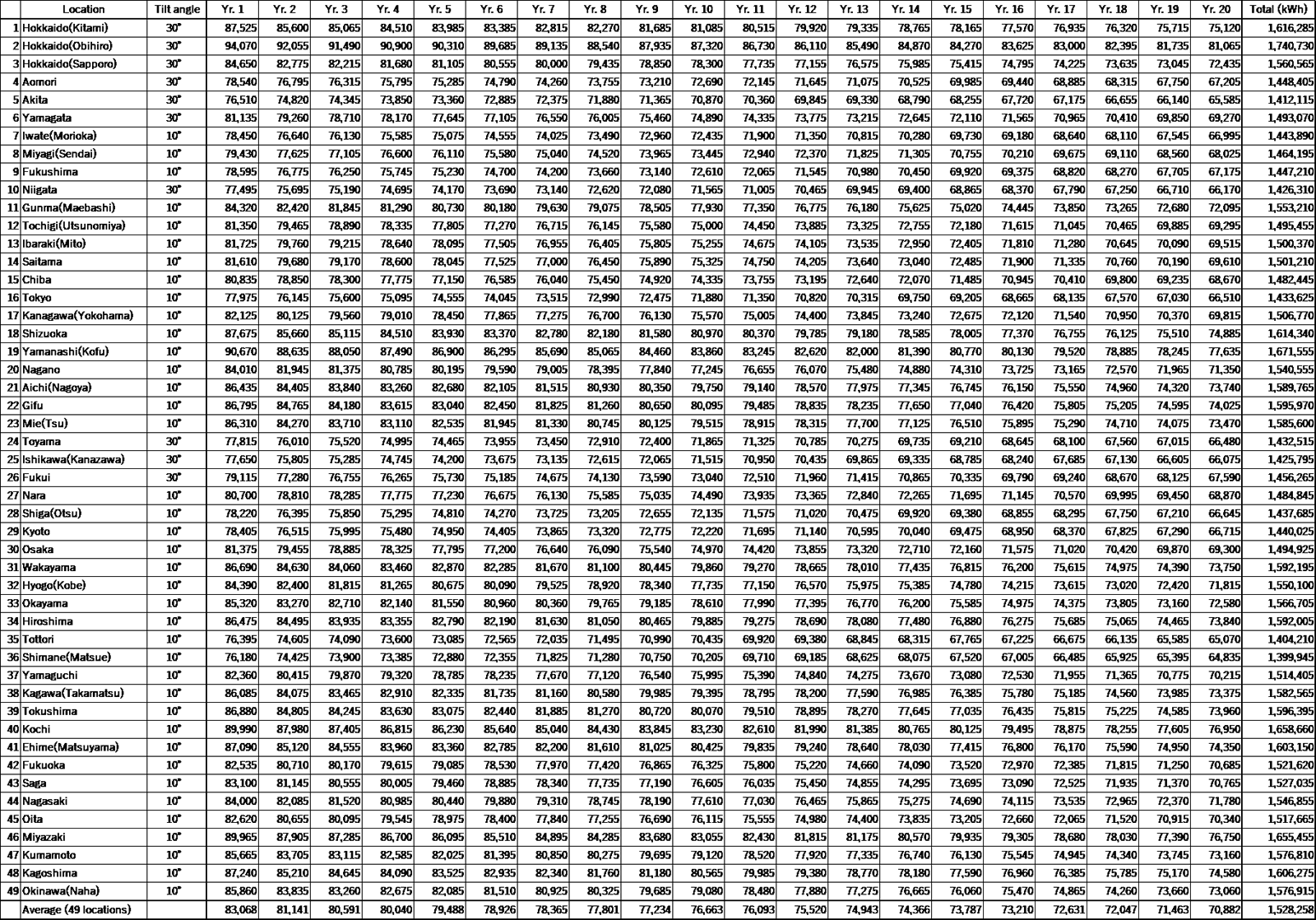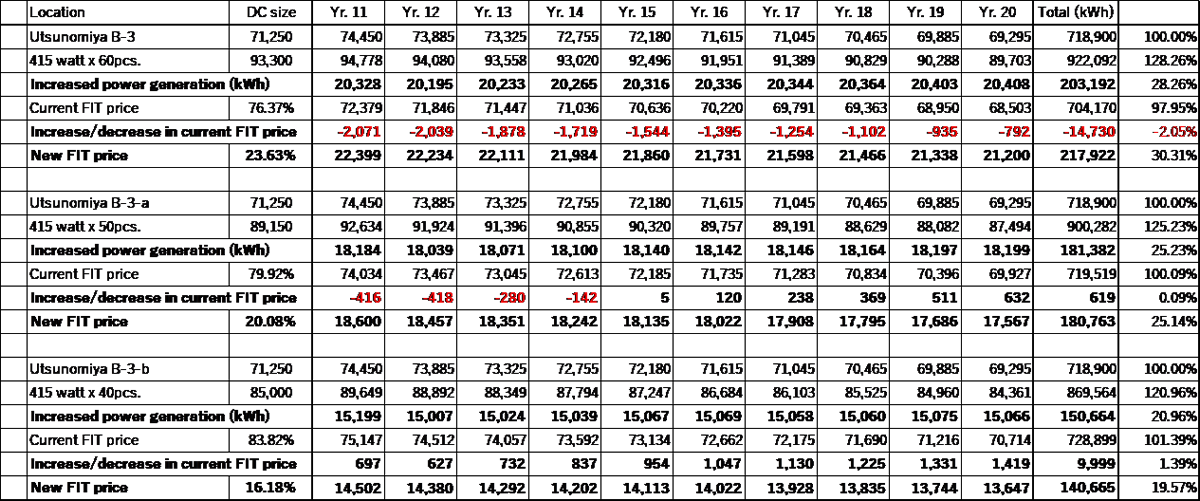PV column
consulting
2023/01/11
Comparative evaluation of panel replacement/addition and PV inverter replacement in PV power plants (B. Three-phase, low voltage)
In this column, same as previous column, we summarized the results of the comparative evaluation of panel expansion and repowering using a model PV power plant (low voltage, three-phase) as an example.
<Price Change Formula>

B. Model PV power plant (Three-phase, low voltage):
(a) Photovoltaic panel: polycrystalline 285 watt, 250 panels, total panel output 71,250 watts. First year degradation rate: 2.5%, annual degradation rate (after 2nd year): 0.7%.
(b) PV inverters: 5 units, Three-phase 9.9kW (7 input circuits and 1 MPPT circuit). Conversion efficiency: 93.0%, incl. isolation-transformer.
(c) System requirements (per PV inverter): 10 series x 5 input circuits, 50 units, 14,250 watts, DC/AC ratio 143.94%.
(d) Others: direction 0-deg facing south, tilt angle of 10-deg or 30-deg, system efficiency 97%.
Table 1. Annual power generation in Japan (49 locations) over a 20-year period:

We estimated and evaluated three proposals for a model PV power plant (Three-phase, low-voltage) after 10 years of operation, and for the case where the plant is renovated or expanded in the 11th year.
Renovation proposal B-1:
- Replacement of all (250pcs.) high output panel monocrystalline 315 watt of the same size (1640mm x 992mm x 35mm)
- Total panel output increases from 71,250 watts to 78,750 watts.
- Panel degradation: first year 2.5%; annual degradation (after 2nd year) 0.7%.
- PV inverters, system configuration, and mounting structures remain unchanged.
- Continued capacity at current FIT price: 71,250 ÷ 78,750 = 90.48%
- Capacity at new FIT rate: 7,500 ÷ 78,750 = 9.52%.
- Additional cost: 250pcs. of monocrystalline 315watt panels + panel replacement cost
Table 2. Renovation proposal B-1 (Average, 49 locations in Japan):

The simulation results show that the amount of electricity generated over the remaining 10 years will increase by approximately 18%. On the other hand, the increase generation of the current FIT price is approximately 7%, and the increase generation of new FIT price is approximately 11%. In case of the current FIT price is 40 yen/kWh and the new FIT price is 10 yen/kWh,

the income from electricity sales increased by approximately 2.82 million yen, or 9.8%.
The DC/AC ratio of the PV power plant in the model example is not too large (143.94%), and the increase in panel capacity of the proposed renovation (7,500 watts, 10.53%) is not too large, so the renovation will be effective without losing the current FIT price. However, we suspect that there is a difficulty in cost-effectiveness relative to the cost of 315 watt (250pcs. of monocrystalline solar modules) of replacement solar modules, which is the main source of the additional cost.
Renovation plan B-2:
- Panels were replaced with 250pcs. high output panels (monocrystalline 425watt: 1762mm x 1134mm x 30mm) and the mounting structures were modified.
- Total panel output increased from 71,250 watts to 106,250 watts.
- Panel degradation: first year 2.0%, annual degradation (after 2nd year) 0.55%.
- Replaced with PV inverters, 9.9 kW, 93.7% conversion efficiency, 5 input circuits, 5 MPPT circuits, incl. isolation-transformer.
- Continued capacity at current FIT price: 71,250 ÷ 106,250 = 67.06%
- Capacity at new FIT price: 35,000 ÷ 106,250 = 32.94%.
- Additional costs: Three-phase 9.9 kW PV inverters (5 units), related equipment, and replacement costs + monocrystalline 425watt panels (250 pcs.), replacement costs + mounting structure modification costs + wiring work, etc.
Table 3. Renovation plan B-2 (Average, 49 locations in Japan):

The simulation results show that the amount of electricity generated over the remaining 10 years will increase by approximately 48.7%. On the other hand, the increase or decrease of the generation of the current FIT price decreased by approximately 0.3%, while the increase or decrease of the generation of the new FIT price increased by approximately 49%, showing a marked decrease in the current FIT price. In case of the current FIT price is 40 yen/kWh and the new FIT price is 10 yen/kWh,

the income from electricity sales increased by approximately 3.43 million yen, or 11.9%.
As shown in the comparison of renovation proposals B-1 and B-2 above (see below), although the amount of electricity generated can be expected to increase as the additional capacity increases, the increase in the ratio of the additional FIT unit price makes it difficult to increase the income from electricity sales.
Table 4. Comparison, Model PV plant, renovation plan B-1 and B-2:

Renovation plan B-3
- Replaced with PV inverters, 9.9 kW, 93.7% conversion efficiency, 5 input circuits, 5 MPPT circuits, incl. isolation-transformer.
- Utilizing existing panels and racks while also adding panels (1720mm x 1134mm x 30mm) and mounting structures
- Existing 285wp panels: 12 in series x 5 inputs x 4 PCS (285watt x 240 panels, 68,400 watts)
- Additional 415wp panels: 12 in-series x 5 inputs x 1 PCS (415watt x 60 panels, 24,900 watts)
- Total panel output increased from 71,250 watts to 93,300 watts.
- Panel degradation (additional panels): the first year 2.0%, annual degradation (after 2nd year) 0.55%.
- Continued capacity at current FIT price: 71,250 ÷ 93,300 = 76.37%.
- Capacity at new FIT price: 22,050 ÷ 93,300 = 23.63%.
- Additional costs: Three-phase 9.9 kW PV inverters (5 units), related equipment, and replacement costs + additional monocrystalline 415watt panels (60 pcs.) + mounting structures for additional panels (for 60 panels) + wiring and installation work, etc.
Table 5. Renovation plan B-3 (Average, 49 locations in Japan):

The simulation results show that the amount of electricity generated over the remaining 10 years will increase by approximately 28%. On the other hand, the increase or decrease of the generation of the current FIT price decreased by approximately 2.3%, while the increase or decrease of the generation of the new FIT price increased by approximately 30%, showing a marked decrease in the current FIT price significantly. In case of the current FIT price is 40 yen/kWh and the new FIT price is 10 yen/kWh,

the income from electricity sales increased by approximately 1.51 million yen, or 5.3%.
We aimed to improve the cost-effectiveness of the renovation by adding more panels while utilizing the existing panels and mounting structures, but the DC/AC ratio factor of the added panels (415 watt x 60 panels, 24,900 watts) and PV inverter (9,900 watt) was too large, resulting in a large peak shaving amount, which had a large impact on the reduction in the current FIT price application.
Comparison by changing the number of panels based on the renovation plan B-3
Simulated Utsunomiya City, Tochigi Prefecture, which is close to the national average, as an example, we compared the capacity of 60 panels (renovation plan B-3), 50 panels (B-3-a), and 40 panels (B-3-b) in the expansion part.
- Replaced with PV inverters, 9.9 kW, 93.7% conversion efficiency, 5 input circuits, 5 MPPT circuits, incl. isolation-transformer.
- Utilizing existing panels and racks while also adding panels (1720mm x 1134mm x 30mm) and mounting structures.
- The 4 PCS part remains unchanged from Proposal B-3.
Existing 285 wp panels: 12 in series x 5 inputs x 4 PCSs (285 watts x 240 panels, 68,400 watts) - The panel capacity of the remaining one PCS unit is compared in three DC size.
B-3. Additional 415wp panel: 12 in series x 5 inputs x 1 PCS
B-3-a. Additional 415wp panel: 10 in series x 5 inputs x 1 PCS
B-3-b. Additional 415wp panel: 8 in series x 5 inputs x 1 PCS
Table 6. Comparison based on Renovation plan B-3 (Utsunomiya City, Tochigi Prefecture):

Although the amount of electricity generated is slightly reduced by reducing the number of panels, it is clear that the current FIT price is applied to a larger amount of electricity.
Table 7. Comparison results of renovations plan B-3, B-3-a, and B-3-b (Utsunomiya City, Tochigi Prefecture):

A reversal result was observed, with more income from electricity sales at panel capacities of 89,150 watts and 85,000 watts than at panel capacity of 93,300 watts. By comparing “the ratio of the current module capacity of the PV power plant to the capacity of the expansion” and “the DC/AC ratio of each PCS and panel,” it is clear that it is possible to compare the cost-effectiveness of the expansion.
The results (model PV plant data, B-1, B-2 and B-3 in 49 locations in Japan) of this simulation (Excel format) can be downloaded here.
As specialist in solar energy, we provide support for various projects, including consultation on expansion, renovation, and repowering of high-voltage and ultra-high-voltage power plants, and design consultation on product selection, panel/PV inverter capacity, and DC/AC ratio for self-consumption. If you have any interests or questions in your PV projects, please feel free to contact us.

